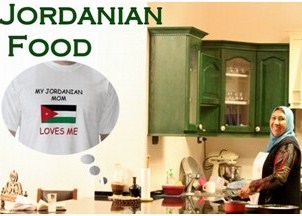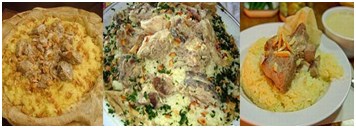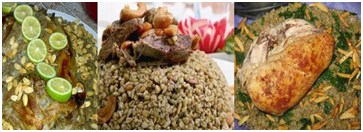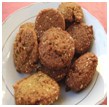
Arabic - Jordanian Cuisine
Arabic cuisine in general is influenced by the nomadic Bedouins, and especially the cuisine of Lebanon, Syria and Palestine. Jordan's cuisine is part of this culinary heritage, and shares many of the characteristics. Within the Arabic culture food is an important aspect and used to express hospitality and generosity, Arabic cuisine delights the gourmet, and feasting is a preoccupation not only of Jordan, but of the Middle East as a whole. In culinary terms, the Middle East enjoys one of the worlds most sophisticated and elaborate cuisines, and are rated among the finest foods in the world. Dishes will even satisfy the health conscious because many of them are made with grain, cheese, yogurt, fresh and dried fruits and vegetables. With the use of these grains & vegetables, meat goes a long way and even the simplest Ingredients can produce a surprisingly attractive creation. Jordan's cuisine, although unique, is part of this distinctive Culinary heritage, which have been savored for well over a thousand years………

Mansaf
The national dish of Jordan is Mansaf: lamb seasoned with aromatic herbs, sometimes lightly spiced, cooked in yoghurt, and served with huge quantities of rice. Feasting on Mansaf is taken seriously, and hours are spent in its preparations, Mansaf is cooked in jameed (the Arabic word for dried yoghurt), which is then mixed with water in a tray to produce a creamy sauce. This is poured into a large stewing pot with chunks of lamb meat. The pot is put over an open fire.As the stew begins to warm, it is
stirred to prevent the yoghurt from separating; large trays are covered with the doughy flat Arabic bread and dampened with yoghurt. On top of this, a layer of rice is heaped. The meat is then piled on top. Almonds, pine-kernels and other nuts may be sprinkled over the dish, which is then ready for serving.
Stuffed Baby Lamb
It is a popular dish in Jordan, which people enjoy as a big and heavy meal. It consists of roasted lamb, stuffed with rice, chopped onions, nuts and raisins.The first and most important thing to do before buying the lamb is to have the butcher clean it and remove the entrails. The lamb should be rinsed well inside and out and wiped until dry with clean cloth. Also brush the lamb inside and out with the seasonings (ground coriander
and ground ginger) and the Onion juice, then just set it aside while preparing the stuffing. The rice should be boiled until it is tender, then it should be drained, Chop some onions and then sauté them in olive oil. Add chopped pistachio nuts, chopped almonds and seedless raisins to the rice. To add a final touch, season the rice with salt and pepper, the oven should be preheated at 450 degrees Celsius. Stuff the lamb and then saw it up with a strong thread. Place the stuffed lam on large baking tray and put it into the oven, then reduce the heat to about 325 degrees Celsius. The lamb should be roasted for about 2 hours and turned over once or twice for well-done meat.

MASHAWI (Mix Grill)
It is infuses rich Jordanian - Lebanese cuisine with distinctive Arabic hospitality, combine ground lamb with fresh herbs, onion, and bread crumbs, and then shape the mixture into logs before you skewer and grill. Cucumber and yogurt team up as a garden-fresh sauce to be served with the kabobs, the main course mixture of kababs orfali and kafta, freshly cut lamb and chicken dices
Mezze
Probably the most popular and well know out of all the middle-eastern cuisines, Arabic - Lebanese food which it is definitely one of the best anywhere in the world, One recipe (or rather, a group of recipes) that particularly stands out from all the other Lebanese foods is the Mezze. It’s a mixture of about 30 (maybe more or less, but usually, it’s thirty) dishes, hold and cold, served simultaneously, the dishes in a particular Mezze can
vary, but the general protocol is that every Mezze would typically have salads (Fattoush is an Example), sauces or dips (such as Hummus and Matoubal) and patties (such as Sambusacs and croissants) and finally the stuffed grape leaves, which are an integral part of the Mezze, Lebanese cuisine has a rich collection of foods and recipes that are local to the region.
Musakhan
Meltingly tender chicken with the lemony flavor of sumac and the sweetness of caramelized onions, musakhan (المسخن) is a favorite dish of Jordanian & Palestinians everywhere. Sheets of flatbread encase the chicken as it cooks, protecting it from direct heat and soaking up delicious juices. Musakhan is traditionally eaten with the fingers. Sometimes spelled moussakhan or musakhkhan
Maqluba
Sometimes pronounced as Maaluba or Magluba (Arabic: مقلوبة) is a traditional Levantine dish, believed to have originated in historic Palestine, the dish includes a meat, rice and fried vegetables placed in a pot, which is then flipped upside down when served, hence the name maqluba which translates literally as "upside-down", The dish is of Palestinian origin, with ingredients commonly found in Palestinian farms and homes. The dish
can include a variety of vegetables, Such as fried tomatoes, eggplants, potatoes, cauliflower, Eggplant and chicken or lamb, when the casserole is inverted, the top is bright red from the tomatoes that now form the top layer and cover the golden eggplant. Maqluba is usually served with either yogurt and/or a simple Arabic salad (salata Arabia) of diced tomato, cucumber, parsley and lemon juice, often mixed with a tahina sauce.
Zarb
Zarb is a traditional Bedouin meal that is served to honor guests to one's home. A unique underground grilling method in a mud oven, served with rice and vegetables, In the past, zarb was made in a hole in the ground or in small caves in the mountains packed tightly with mud and sand. Today, zarb is usually made in an iron barrel set into a hole in the ground. First, wood is burned to create charcoal. Then, spiced meat, chicken and
vegetables are placed on an iron tray. The tray is placed in the barrel and the barrel is sealed and buried in the sand for three hours. The barrel's contents bake in their juices and once the meal is uncovered, guests enjoy a truly delicious meal!
Mandi
Al Mandi is originally from Yemen, it's one of the most lovable recipes in Yemen especially in Hadhramaut (one of Yemen countryside), the main ingredients are chicken, rice and carrots, our recipe is belong to Jordanian style, it's simply delicious, usually made with a lamb or chicken, basmati rice, and a mixture of spices. The meat used is usually a young and small sized lamb to enhance the taste further, Mandi is considered as the main dish served in special events such as weddings and feasts.
Al Qdree
Known for a Palestinian dish, especially the people of Hebron, Cooker of pottery is the secret of this dish & its spices only found in Palestine and Jordan, made out from meat, garlic, rice & very unique spices.
Maftoul
The Muftol is one of the most popular dishes common and popular in Palestine & Jordan, Couscous is made out of two parts semolina, one part flour, water and salt. Semolina is put on a plate and moistened with saltwater. The semolina water mixture is hand molded and flour is added. Then, small grains of couscous are separated. Once grains of the right size are produced, oil is added and the couscous is ready for steaming, It is
different than Moroccan version, its much larger its texture is creamier, Served warm, this pearl-like pasta is pure comfort food. The Palestinian traditionally serves it pilaf-style with chicken or lamb. Cook it with a little vegetable stock, and then add some petit black lentils, chopped peppers, olives, onions, tomatoes, herbs, and a little citronette for a superb salad." Try this authentic recipe that takes time to prepare but is totally worth it especially for family gatherings

Freekeh
(Sometimes spelled frikeh) or farik (Arabic: فريكة) is a cereal food made from green wheat that goes through a roasting process in its production. It is an Arab dish that is especially popular in Palestinian and Egyptian cuisine, The wheat is harvested while the grains are yellow and the seeds are still soft; it is then piled and sun-dried. The piles are then carefully set on fire so only the straw and chaff burn and not the seeds. It is the high moisture content of the seeds that prevents them from burning.
The now roasted wheat undergoes further thrashing and sun-drying to make the flavor, texture, and color uniform. It is this thrashing or rubbing process of the grains that gives this food its name, farīk or “rubbed.” The seeds are now cracked into smaller pieces so they look like a green bulgur.
Mahashi (stuffed vegetable)
Arab cooks are the masters of the stuffed vegetable, This delicious recipe found in many variations throughout the Middle East, especially Jordan, Syria and Lebanon, these dishes is served hot as a main course , Zucchini ,cabbage, Vine Leaves , potato, Eggplant, Tomato, Carrots, capsicum , Is filled with mix minced meat, parsley, coriander, onion, mint, margarine, salt and pepper.

Shawarma (Arabic: شاورما)
Is a popular Levantine Arab meat preparation, where lamb, goat, chicken, beef, or mixed meats are placed on a spit (commonly a vertical spit in restaurants), and may be grilled for as long as a day. Shavings are cut off the block of meat for serving, and the remainder of the block of meat is kept heated on the rotating spit. Although it can be served in shavings on a plate (generally with accompaniments), "shawarma" also refers to a pita bread sandwich or wrap made with shawarma meat. Shawarma is eaten with tabbouleh, fattoush, taboon bread, tomato, and cucumber. Toppings include tahini, hummus, pickled turnips and amba. Shawarma is a fast-food staple across the Middle East, Europe and the Caucasus.

Falafel
Grew to become a common form of street food or fast food in the Middle East, it’s a popular food in Syria, Turkey, Saudi Arabia, Iraq, Palestine, Jordan, Lebanon, Egypt, Yemen and Sudan, which is made from dried leguminous vegetables and soaked for a period of water and then grind and kneaded and then fried impress in hot oil in the form of tablets. Falafel is of two types, one is made from beans ground as is the case in Egypt or ground chickpeas as being the practice in the Levant and This is a great way of getting your protein in without the meat.
An Arabic food experience is only completed with a dessert.
Baklava
is a rich, sweet pastry made of layers, filled with nuts, cinnamon and sweetened with honey.
Kanafa
A traditional dessert which is very popular in the Levant region of the Middle East specially in Lebanon, Palestine, Jordan & Syria , is a pastry filled with nuts or goats cheese. It consists of a base layer made of cheese mixed with milk or cream, a crispy layer of dried noodles and often topped off with some syrup.
Ataif
is the traditional sweet that is made during the Holy month of Ramadan. It's well known in all Arab Countries. It is really simple to make, and as long as they are pinched closed, they should come out great, is a small fried Pancake filled with nuts or cheese.
Mohallabiya
A classic dessert, is a rice pudding perfumed with rose water or orange, flavored with spices and garnished with nuts
Awama
Its form of street sweet in the Middle East, This awamat recipe or awama is easy and delicious authentic Lebanese dessert dish that you can find everywhere.
Joining local people for a cup of tea or coffee can be a wonderful way to learn more about local culture. If you are invited yet are unable to attend, then it is perfectly acceptable to decline. Place your right hand over your heart and politely make your excuses.
Food & eating well represents part of the Jordanian tradition & culture. Serving certain dishes at certain social occasions has been an old inherited tradition in Jordan. We recommend that you try out some of the most famous Jordanian dishes while you are in Jordan. There are many fine restaurants that offer a wide selection of authentic Arabic and Jordanian food at reasonable prices.